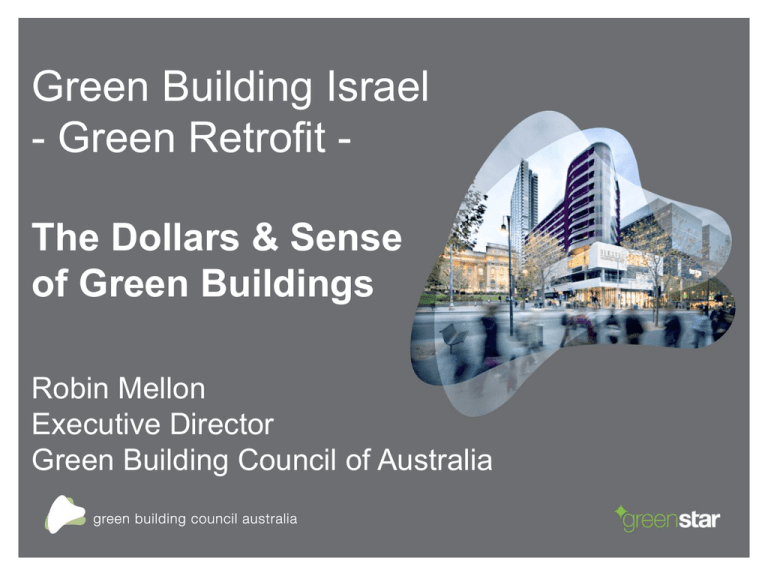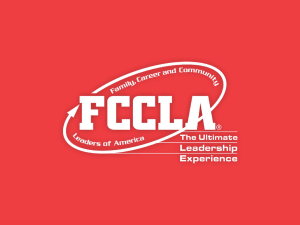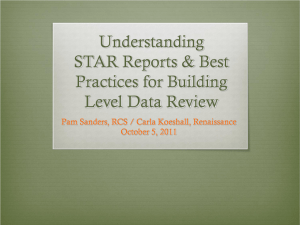Green Star Communities
advertisement

Green Building Israel - Green Retrofit The Dollars & Sense of Green Buildings Robin Mellon Executive Director Green Building Council of Australia Outline of the session • The dream – and the way forward • The work of the GBCA • The Green Star rating tools and categories • Defining ‘best practice’ • Case studies of Australian projects • The true ‘cost’ and ‘value’ of green buildings • Green Star Communities • Conclusion – where do we go from here? • The dream – and the way forward Green Building Council of Australia (GBCA) strategic activities The GBCA is a member-based, non-governmental organisation (NGO) started in 2002, run as a not-for-profit, and now with over 910 member companies across the industry and 60 staff across the country, with three main objectives; - RATE buildings and tenancies - EDUCATE the industry - ADVOCATE to local, state and federal government The Green Star rating tools are run by the GBCA as Australia’s only voluntary, holistic sustainability tools for buildings. GBCA member organisations Now over 910 member organisations: Agents, facility and asset managers Building owners Building product manufacturers and suppliers Building tenants Construction companies and developers Environmental organisations Financial institutions Government Professional services and societies Property developers Universities and institutes Green Star rating tools • • • • • • • • • • • Office Design and As Built (v3) Office Interiors (v1.1) Education (v1) Healthcare (v1) Multi Unit Residential (v1) Retail Centre (v1) Industrial (v1) Public Building (in PILOT phase) Custom (under development) Communities (under development) Existing Buildings / Performance tool (under development) NINE ENVIRONMENT IMPACT CATEGORIES Green Building Council of Australia TOOL FRAMEWORK Green Building Council of Australia Green Star projects around Australia Now 269 certified / rated projects Now 493 registered / in progress projects Green Star Education and CPD Different levels of courses: ‘Foundation’ Course Project Certification Workshop Green Star Office Interiors Workshop Online ‘e-learning’ Masterclasses In-house courses Continuing Professional Development (CPD) Advocacy and Government relations Federal, State and Local Advocacy Five ‘green building priorities’ for each level of government: 1. Show government leadership and offer incentives 2. Make Education and Healthcare facilities greener 3. Concentrate on the Existing Building challenge 4. Widen the focus from buildings to communities 5. Embed green skills across the industry How to define best practice? • • • • • • • • • Use of natural resources Use of recycled materials Energy, water benchmarks Waste processes Management practices IEQ – ventilation, comfort and pollution Ecological impacts Architecture and design Construction and demolition practices Vauban district, Freiburg ‘Everything old is new again’ • • • • • • • Return to good passive design principles Balance of passive design and appropriate technology Examples from nature, and learning from the past Industry change from new to interiors to retrofit Old buildings have some amazing opportunities Embodied energy of existing buildings ‘Problem children’ are now in the 20-40 year old age group 39 Hunter Street, Sydney 500 Collins Street, Melbourne 40 Albert Road, Melbourne 40 Albert Road, Melbourne Stockland Offices, Sydney Home HQ Centre, Sydney The Greenhouse, Sydney 100 Market Street, Sydney xx • xx The true cost of ‘green’ Cost is still perceived to be the biggest barrier to building green but sustainable construction is now near cost-neutral • • • • • • Four Star Green Star – cost neutral +/- two per cent Five Star Green Star – cost neutral +/- five per cent Six Star Green Star – World Leadership The concept of ‘pay-back periods’ The balance between treasury and long-term benefits The ‘learning curve’ within the industry The true value of ‘green’ • • • • • • • • • Operational value – energy, water, waste management Asset value – responsibility, flexibility, adaptability – 10% Rental value – short let-out periods, low vacancy – 15% Facility management value – maintenance, replacement Staff value – turnover, absenteeism, productivity Pupil value – reading retention rates, exam results Patient / resident value – satisfaction, health, enjoyment Reputation – satisfaction, ‘brand’ value, awareness Learning value – using buildings as a learning resource The hidden value of ‘green’ • Residential: Case studies show increased asset and rental value, better energy and water efficiency, and vastly better levels of IEQ through better ventilation and greater comfort • Education: Absentee figures decreased, reading retention rates increased by up to 28%, examination results improved by 512%, staff turnover decreased (2007) • Healthcare: A study of patients assigned to both sunny and shady rooms post-surgery showed those exposed to 46% more sunlight experienced less stress, reported less pain, and took 22% less pain medication, resulting in 20% lower costs (2005) The Pixel Building, Melbourne Green Star Communities The Green Star Communities framework, as well as the rating tool being developed, follows five key principles: • • • • • Enhance liveability Create opportunities for economic prosperity Foster environmental responsibility Embrace design excellence Demonstrate visionary leadership and strong governance. What is a sustainable community? Conclusion • • • • • • • Policies to equal our passion Leadership from private and public sectors Integrated approach Everything old can be new again The ‘green dream’ is much more persuasive The conversation is about good business sense Retrofits provide some of the best opportunities SAVE THE DATE 27 FEBRUARY – 2 MARCH 2011 MELBOURNE CONVENTION & EXHIBITION CENTRE GREENCITIES.ORG.AU






